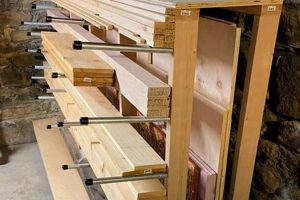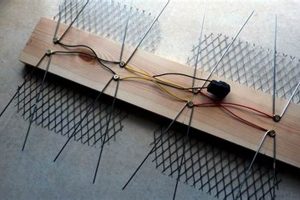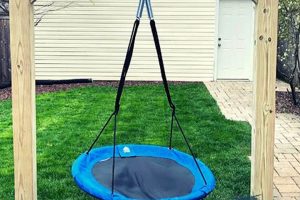A shop-made apparatus, often constructed from readily available materials, facilitates the controlled movement of a router across a workpiece. This jig provides a stable platform, enabling precise flattening, surfacing, or shaping of materials that exceed the capabilities of traditional jointers or planers. For example, a warped or uneven wooden slab can be rendered flat and parallel using this technique.
Employing such a device allows woodworkers to tackle projects involving large or irregularly shaped pieces, ensuring consistent results and minimizing material waste. The ability to achieve perfectly flat surfaces is crucial for various woodworking applications, including table tops, doors, and cabinet components. Historically, these jigs evolved as a cost-effective alternative to expensive industrial machinery, empowering hobbyists and small-scale professional woodworkers alike.
The following sections will delve into the design considerations, material selection, construction techniques, and practical applications associated with these user-built router-based surfacing solutions. Focus will be given to optimizing performance and accuracy while maintaining a budget-conscious approach.
Operational Refinements for Enhanced Surfacing
The effective use of a router-based surfacing jig hinges on meticulous setup and consistent operational practices. The following tips offer guidance for achieving optimal results.
Tip 1: Secure Workpiece Stabilization: Ensure the workpiece is firmly anchored to the supporting surface. Clamps or non-slip mats should be strategically positioned to prevent movement during the routing process. Any instability can lead to inaccuracies and potential damage.
Tip 2: Optimize Router Bit Selection: Employ a surfacing bit with a diameter appropriate for the scale of the project. Larger diameter bits expedite material removal, while smaller bits are suitable for finer detailing. A sharp, well-maintained bit is essential for a clean, tear-out-free cut.
Tip 3: Implement Incremental Depth of Cut: Avoid aggressive material removal by making multiple passes with shallow depth settings. This reduces stress on the router, minimizes vibration, and improves surface finish. A depth of cut no greater than 1/8 inch is generally recommended for hardwoods.
Tip 4: Maintain Consistent Feed Rate: A steady and controlled feed rate is crucial for achieving a uniform surface. Moving the router too quickly can result in a rough cut, while moving too slowly can cause burning. Experiment to determine the optimal feed rate for the specific material and router bit combination.
Tip 5: Employ Dust Collection: Equip the router with a dust collection system to remove debris and improve visibility. Dust accumulation can impede the router’s movement and compromise the accuracy of the cut.
Tip 6: Check Sled Alignment: Routinely verify the alignment of the sled rails to ensure they are parallel and level. Misalignment can introduce inconsistencies in the surfaced workpiece.
Tip 7: Consider Sacrificial Spoil Board: To prevent damage to the supporting surface, incorporate a sacrificial spoil board beneath the workpiece. This also helps to maintain consistent router bit depth.
Adherence to these principles contributes to a more precise and efficient surfacing process, maximizing the potential of the system. Thorough preparation and controlled execution are key to achieving professional-quality results.
The subsequent section will address common challenges encountered during the construction and utilization of these homemade jigs and provide solutions for overcoming them.
1. Sled Base Stability
The stability of the sled base is paramount to the overall effectiveness of a user-constructed router surfacing system. The base serves as the foundation upon which the router moves, dictating the planarity and uniformity of the resulting surface. Any deficiencies in the base’s rigidity or dimensional accuracy directly translate into imperfections in the workpiece.
- Material Selection and Rigidity
The choice of material for the sled base significantly impacts its stability. Plywood or MDF are commonly employed due to their dimensional stability and affordability. However, the thickness and internal structure of the chosen material must be sufficient to resist deflection under the weight of the router and the forces generated during cutting. Inadequate thickness can lead to warping or bending, compromising the accuracy of the surface. For example, using a 1/2″ plywood for a large sled base will almost certainly result in unwanted flex during routing.
- Construction Techniques and Joint Integrity
The method of constructing the sled base, including joinery and fastening techniques, plays a vital role in its structural integrity. Weak or poorly executed joints can introduce play and flexibility, negating the benefits of using high-quality materials. Reinforced joints, such as those employing screws and glue or mortise-and-tenon joinery, are preferred for their ability to withstand stress and maintain dimensional accuracy over time. A sled base with simply butt-jointed corners, for instance, will likely loosen and shift with use.
- Surface Flatness and Parallelism
The flatness of the sled base and the parallelism of its bearing surfaces are critical for achieving consistent results. Any deviation from a perfectly flat plane will be transferred to the workpiece, resulting in an uneven surface. Similarly, if the rails or runners on the base are not parallel to the cutting plane of the router bit, the resulting surface will be tapered. Careful attention to detail during construction, including the use of precision measuring tools and accurate assembly techniques, is essential to ensure flatness and parallelism. Using winding sticks to check for twist across the sled base is an important construction step.
- Mitigating Vibration and Resonance
The inherent vibration produced by the router during operation can be amplified by the sled base, leading to chatter and an undesirable surface finish. Damping materials, such as rubber or neoprene pads, can be strategically applied to the base to absorb vibration and minimize resonance. Furthermore, increasing the mass of the base can also help to reduce vibration by increasing its inertia. A lightweight sled base with no damping material is prone to excessive vibration, especially when working with dense hardwoods.
In conclusion, sled base stability is not simply a desirable attribute, but a fundamental requirement for any router flattening jig. Careful material selection, robust construction techniques, and meticulous attention to detail are essential for creating a base that provides a stable and accurate platform for the router, ultimately resulting in a flawlessly surfaced workpiece. The performance is intrinsically linked to each element.
2. Rail system precision
The accuracy of the rail system within a user-built router flattening apparatus directly dictates the achievable level of surface planarity. Deviations from perfect straightness, parallelism, or levelness in the rails induce corresponding errors in the final surface. This cause-and-effect relationship underscores the rail system’s critical importance as a primary determinant of the device’s performance. For instance, if the rails are not perfectly parallel, the router will cut at a slight angle, resulting in a tapered workpiece rather than a uniformly flattened one.
Practical application of this understanding manifests in several construction and operational considerations. Careful selection of rail materials, such as precision-ground steel or straight-grained hardwood, minimizes inherent warping or bending. Precise alignment during assembly, verified with accurate measuring tools like dial indicators and precision levels, ensures parallelism and levelness. Furthermore, periodic inspection and adjustment are necessary to maintain rail system accuracy over time, accounting for potential wear or environmental factors. An example is the use of shims to correct minor deviations in rail height or parallelism.
In summary, rail system precision represents a non-negotiable requirement for achieving high-quality surfacing results with a homemade router sled. The challenges associated with constructing and maintaining a truly precise rail system necessitate careful planning, meticulous execution, and ongoing diligence. Addressing these challenges effectively links directly to the broader goal of producing dimensionally accurate and aesthetically pleasing wooden components.
3. Router bit selection
The selection of an appropriate router bit is an essential aspect of operating a shop-fabricated router flattening system. Bit characteristics influence material removal rate, surface finish quality, and the overall efficiency of the surfacing process. Choosing the correct bit is therefore critical to achieving desired results.
- Diameter and Cutting Edge Geometry
Larger diameter bits generally remove material more quickly due to their increased cutting surface. However, they may also require more powerful routers to maintain a consistent cutting speed. The cutting edge geometry, such as straight, spiral, or compression, affects the smoothness of the cut and the likelihood of tear-out. For example, a spiral upcut bit excels at material removal but may produce tear-out on certain woods, while a compression bit offers a cleaner finish but removes material more slowly.
- Bit Material and Coating
Router bits are typically made from high-speed steel (HSS) or carbide. Carbide bits offer superior durability and can maintain their sharpness for longer periods, especially when working with abrasive materials. Coatings, such as titanium nitride (TiN) or diamond-like carbon (DLC), can further enhance bit life and reduce friction. A carbide bit with a DLC coating is often preferable for surfacing hardwoods due to its longevity and ability to maintain a clean cutting edge.
- Surfacing-Specific Bit Designs
Specialized surfacing bits are designed to create a perfectly flat surface with minimal passes. These bits often feature a large diameter, multiple cutting edges, and a flat bottom. Some designs incorporate replaceable carbide inserts, allowing for easy maintenance and cost-effective replacement of worn cutting edges. For instance, a “spoilsboard surfacing bit” is specifically designed to flatten large areas quickly and efficiently.
- Shank Size and Router Compatibility
The shank size of the router bit must be compatible with the router’s collet. Common shank sizes are 1/4 inch and 1/2 inch. Using an incorrectly sized shank can damage the router and create a safety hazard. Furthermore, the router’s horsepower and speed range must be appropriate for the size and type of bit being used. A large-diameter surfacing bit requires a powerful router with variable speed control to prevent excessive vibration and motor overload.
The interplay between router bit characteristics and material properties requires careful consideration. The choice of bit influences not only the speed of material removal but also the quality of the resulting surface. Therefore, understanding the strengths and limitations of different bit designs, materials, and coatings is essential for optimizing the performance of any shop-fabricated router flattening system.
4. Depth control mechanism
The depth control mechanism is an indispensable component of a user-constructed router flattening system. It regulates the vertical position of the router bit relative to the workpiece, directly influencing the amount of material removed in each pass. Insufficient control over cutting depth results in uneven surfaces, inefficient material removal, and potential damage to both the workpiece and the router bit. For example, a sled lacking a precise depth adjustment might inadvertently remove excessive material, leading to a thin or weakened workpiece, or conversely, remove too little, requiring numerous passes and extending project time unnecessarily.
Effective depth control can be achieved through various designs, ranging from simple shimming techniques to more sophisticated micro-adjustment mechanisms. A common approach involves incorporating threaded rods and locking nuts to provide incremental vertical movement of the router platform. In this configuration, each rotation of the nut corresponds to a precisely defined change in cutting depth. For instance, a threaded rod with a pitch of 1mm would allow for depth adjustments in 1mm increments per full rotation. More advanced systems may utilize dial indicators or digital readouts to display the precise cutting depth, facilitating repeatable and accurate adjustments.
In summary, the depth control mechanism is not merely an accessory but an essential element of a router sled. Its design and implementation directly influence the accuracy, efficiency, and safety of the surfacing process. Careful consideration of the mechanism’s precision, ease of use, and robustness is crucial for achieving professional-quality results. The effectiveness of the entire router sled system is limited by the precision and reliability of its depth control capabilities.
5. Workpiece securement
Workpiece securement constitutes a critical element in the operational effectiveness of any user-built router flattening system. Proper securement prevents unwanted movement during the routing process, ensuring accuracy and safety while simultaneously safeguarding the workpiece from damage. Without a robust securement strategy, the precision of the jig becomes inconsequential, as any movement negates the controlled cutting action.
- Clamping Mechanisms and Their Application
Clamps represent the primary means of securing a workpiece to the support structure. Various clamp types, including toggle clamps, bar clamps, and cam clamps, offer d
ifferent advantages in terms of clamping force, speed of application, and adaptability to different workpiece geometries. Toggle clamps, for instance, provide rapid and secure clamping with adjustable pressure, making them suitable for repetitive tasks. Proper clamp placement is crucial; clamps should be positioned to distribute force evenly across the workpiece, minimizing the risk of distortion or slippage. An uneven clamping force can cause the workpiece to bow, leading to inaccurate surfacing. - Friction-Enhancing Techniques
In addition to clamping, friction-enhancing techniques can further improve workpiece stability. Non-slip mats, sandpaper, or specialized friction pads can be placed between the workpiece and the support surface to increase the coefficient of friction, resisting lateral movement. These techniques are particularly useful for securing workpieces with irregular shapes or smooth surfaces that are prone to slipping. Applying double-sided tape to the underside of a small workpiece can provide additional grip, preventing it from shifting during routing.
- Addressing Workpiece Geometry
The geometry of the workpiece significantly influences the securement strategy. Large, flat workpieces may require multiple clamps strategically placed to prevent warping or bowing. Irregularly shaped workpieces may necessitate custom-designed clamping jigs or fixtures to provide adequate support and securement. For example, securing a live-edge slab often requires the use of custom-shaped cauls and multiple clamps to conform to its irregular contours, preventing movement during the surfacing process.
- Vacuum-Based Securement Systems
Vacuum-based securement systems offer an alternative to traditional clamping methods, providing a uniform holding force across the entire surface of the workpiece. These systems utilize a vacuum pump to create a negative pressure between the workpiece and a sealed platen, effectively holding the workpiece in place. Vacuum systems are particularly useful for securing thin or delicate workpieces that are susceptible to damage from clamping pressure. They are also advantageous for surfacing large workpieces, as they eliminate the need for numerous clamps and provide unobstructed access to the workpiece surface.
The effectiveness of a user-built router flattening jig hinges on the robustness of the workpiece securement strategy. Combining appropriate clamping techniques with friction-enhancing methods, and adapting the approach to the specific geometry of the workpiece, ensures both accuracy and safety during the surfacing process. While vacuum systems present an attractive alternative, they involve a higher initial investment and require careful consideration of workpiece porosity and vacuum pump capacity.
Frequently Asked Questions
The following questions address common inquiries and concerns regarding the construction, operation, and limitations of shop-built router surfacing apparatus.
Question 1: What are the primary advantages of a homemade router sled over commercially available surfacing solutions?
Construction of a user-built apparatus typically incurs a lower initial cost compared to purchasing a dedicated industrial planer or wide-belt sander. Furthermore, it allows for customization tailored to specific project requirements and available workspace. The adaptability and resourcefulness inherent in the design represent key benefits.
Question 2: What materials are most suitable for constructing a durable and accurate system?
Dense, dimensionally stable materials such as medium-density fiberboard (MDF) or high-quality plywood are recommended for the base and supporting structure. Rails should be constructed from straight, rigid materials like steel or hardwood to ensure accurate router movement. Selection should prioritize minimizing warping and deflection.
Question 3: How can one mitigate vibration and chatter during the surfacing process?
Employing a heavy, rigid base, securing the workpiece firmly, and utilizing a router with variable speed control can minimize vibration. Damping materials, strategically placed, further absorb unwanted resonance. Slow, consistent feed rates and sharp router bits are crucial for preventing chatter.
Question 4: What router bit types are best suited for surfacing large wooden slabs?
Large-diameter surfacing bits, often referred to as “spoilsboard” bits, are designed specifically for rapid material removal over broad areas. These bits typically feature multiple cutting edges and a flat bottom to create a smooth, even surface. Carbide-tipped bits offer increased durability and longevity.
Question 5: How does one ensure that the constructed jig is perfectly level and square?
Employing precision measuring tools, such as levels, squares, and straightedges, is essential throughout the construction process. Careful attention to detail during assembly, coupled with frequent verification of alignment, is crucial for achieving accurate results. Shims and adjustable components can be incorporated to correct minor discrepancies.
Question 6: What safety precautions should be observed when operating a user-built router flattening system?
Eye and ear protection are mandatory. Securing the workpiece firmly is essential to prevent movement. A dust collection system should be used to minimize airborne particles. Familiarization with the router’s operating manual and adherence to all safety guidelines are paramount. Never reach over the operating router.
In summary, careful planning, precise construction, and adherence to safety protocols are fundamental to the successful utilization of a user-constructed router surfacing solution. A thorough understanding of the jig’s limitations is necessary for achieving consistent results.
The subsequent section will examine advanced techniques and modifications that can further enhance the performance and versatility of these devices.
DIY Router Sled
This examination has detailed the multifaceted aspects of the diy router sled, encompassing design, construction, operation, and troubleshooting. The efficacy of such an apparatus hinges on the precision of its components, the stability of its structure, and the operator’s adherence to established safety protocols. The capacity to flatten or surface material exceeding the limitations of conventional machinery offers a cost-effective and adaptable solution for woodworking endeavors.
Given the inherent variability in materials and construction techniques, continuous evaluation and refinement remain essential. Those undertaking the construction and utilization of a diy router sled should prioritize a thorough understanding of its principles, ensuring consistent performance and safe operation. The continued advancement of user-modified woodworking solutions ultimately relies on the meticulous application of engineering principles and a commitment to responsible craftsmanship.







